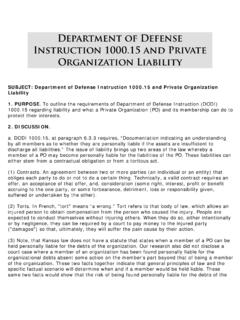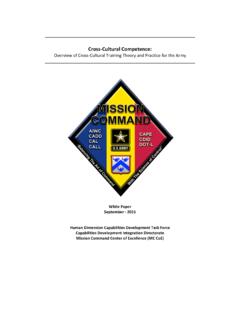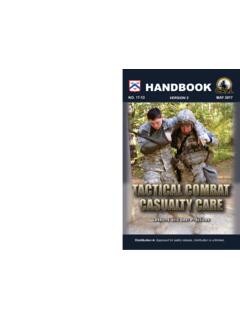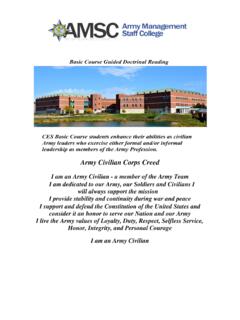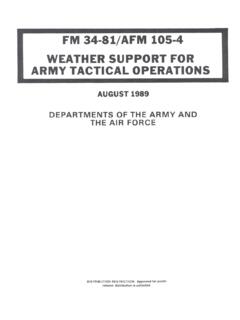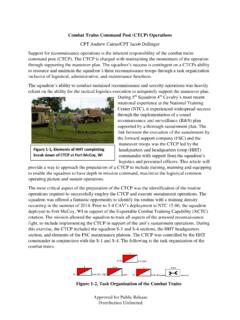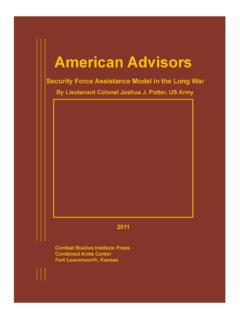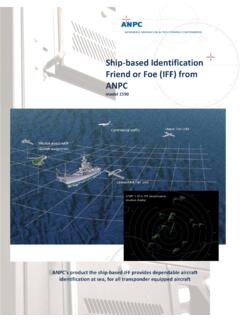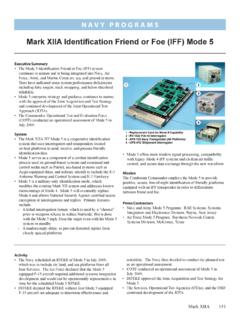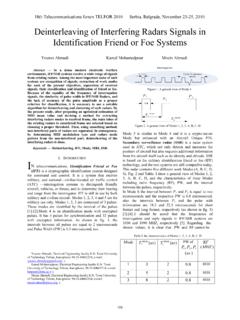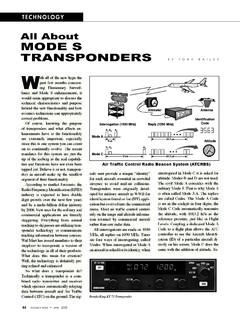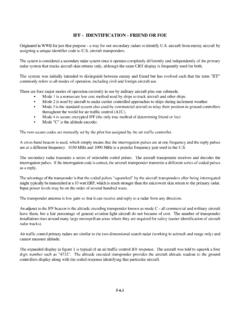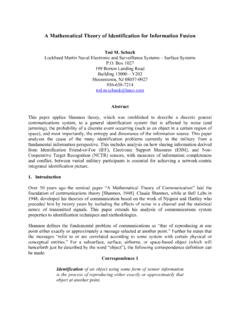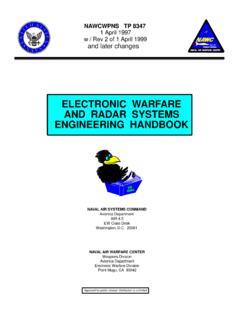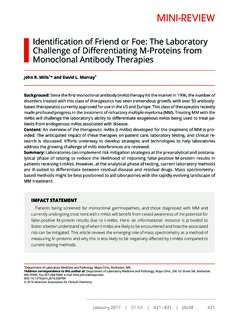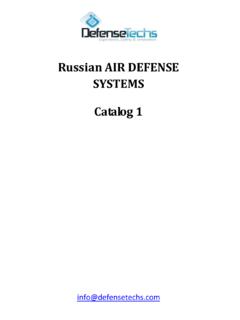Transcription of STINGER TEAM OPERATIONS - Combined Arms Center
1 Field ManualNo. 44-18-1*FM 44-18-1 HEADQUARTERSDEPARTMENT OF THE ARMYW ashington, DC, 31 December 1984 STINGERTEAM OPERATIONS * This field manual supersedes FM 44-18-1, 20 October 44-18-1iii31 December 1984 FM 44-18-1 As part of the Army standardization program, the termssquad and team may be changed to crew. When implementedby ARs, TOEs, etcetera, the terms will be used in subsequentchanges to this revised publication. When used in this publication, he, him, his, and men represent both the masculine and feminine genders unless other-wise 44-18-1 PrefaceThe purpose of this manual is to provide guidance for the STINGER teamin support of air defense OPERATIONS . It is also written to support the trainingof individuals to function as members of a STINGER skilled individuals are molded into efficient, smooth-functioningteams, their capability to accomplish assigned missions is greatly effectiveness of STINGER varies directly with the individual skills of eachteam member and the collective proficiency of each team .
2 The key to both manual focuses on the techniques and procedures used by theStinger team to engage and destroy hostile 44-18-1 consists of two parts:Part I describes the STINGER system and tells how to use the weapon toshoot down aircraft. This part also describes how the team operates II discusses the means and methods of training soldiers to operatethe manual should be used with the system technical manual (TM9-1425-429-12) which tells how the system functions and how to maintain found in the technical manual, such as that on maintenanceand emergency destruction procedures, is not repeated in this is a companion manual to FM 44-18, which tells how STINGER willbe employed at the platoon and section levels, along with other air defenseartillery (ADA) weapons, as an integral part of the Combined arms tactical doctrine and procedures contained in FM 44-18 will be oflittle use if the STINGER team cannot effectively engage enemy aircraft.
3 Itdoes little good to have the STINGER team properly positioned unless the teamchief and the gunner, working together, can engage and kill an enemyaircraft when called upon to do so. This requires training in engagementprocedures, as outlined in this field material contained in this field manual is applicable to bothnuclear and nonnuclear warfare without shown on pages 8 through 17 of Chapter 17, are checklist formats. Those shown are samples for your of FM 44-18-1 are encouraged to submit recommended changes orspecific comments to improve the publication. Comments should be keyedto the specific page and line of text in which the change is should be provided for each comment to insure understanding andcomplete evaluation. Comments should be prepared on DA Form 2028(Recommended Changes to Publications and Blank Forms) and forwardeddirectly to:CommandantUS Army Air Defense Artillery SchoolATTN: ATSA-DTP-EBFort Bliss, Texas ITHE STINGER WEAPON SYSTEMCHAPTER 1 System DescriptionThe STINGER weapon is a man-portable, shoulder-fired,infrared radiation (IR) homing (heat-seeking), guided missilesystem.
4 It requires no control from the gunner after has an identification , friend or foe (IFF), subsystemwhich aids the gunner and team chief in identifying friendlyaircraft. OPERATIONS at night or in adverse weather conditionsare somewhat restricted by the gunner s ability to see andidentify the target. STINGER provides short-range air defense formaneuver units and the less mobile combat support units. TheStinger system is designed to counter high-speed, low-level,ground attack aircraft. STINGER is also a lethal weapon againsthelicopter, observation, and transport .. 1-2 Gripstock Assembly.. 1-6 Missile-Round ..1-2 IFF Support Equipment ..1-7 IFF Subsystem..1-5 Shipping and Storage Containers ..1-91-1FM 44-18-1 READY-ROUNDThe STINGER missile-round consists of aweapon-round to provide prelaunch power toStinger missile sealed in a disposable launchthe system, it becomes a ready-round.
5 Fortube assembly. The STINGER weapon-round isIFF capability, an IFF interrogator is con-made up of a missile-round mated to a separ-nected to the gripstock assembly as illus-able gripstock assembly. When a battery/-trated below. coolant unit (BCU) is inserted into theMISSILE-ROUNDM ajor components that make up the missile are shown in the STINGER Missile-Round guidance section of the missile con-surfaces. The guidance assembly processessists of a guidance assembly, a controltarget IR and provides guidance commandsassembly, a missile battery, and four controlfor the missile during flight. The seeker tracks1-2FM 44-18-1the IR source automatically after the gyro isuncaged and during missile flight. The con-trol assembly converts the guidance com-mands into movement of control surfaceswhich direct the flight of the missile.
6 Themissile battery provides the in-flight powerfor the STINGER guided warhead section consists of a fuzeassembly and a quantity of explosives, allwithin a cylindrical case. After the flightmotor ignites, the fuze arms the fuze can detonate the warhead in twoways: by means of a low impact switch or bya hard target sensor. Should target interceptnot occur within 15-19 seconds after launch, aself-destruct circuit initiates warhead deto-nation. Safety features are included to insurethat the missile is safe for shipping propulsion for the missile is providedby a separable launch motor and a dualthrust flight launch (eject) motor provides initialthrust that ejects the missile from the launchtube. It allows the missile to coast a safe dis-tance (about 9 meters/29 feet) from the gunnerprior to ignition of the flight motor.
7 Thelaunch motor is expended and separatedfrom the flight motor before the missile is outof the launch tube. The expended launchmotor leaves the launch tube and falls a safedistance forward of the gunner. Also, at sepa-ration, a lanyard attached to the launchmotor pulls the shorting plug from the flightmotor ignition circuit, thus enabling the flight motor provides propulsion forthe missile during flight. The flight motorfires after the missile coasts for a safe dis-tance from the gunner. Thrust for the flightmotor is provided in two phases: boost andsustain. Initially, both burn boost phase rapidly accelerates the mis-sile to its top speed. The boost phase ends, butthe sustain phase continues. The sustainphase maintains the missile speed for a timesufficient to complete the tail assembly of the STINGER missileconsists of four folding tailfins that provideroll and missile stability.
8 Within the launchtube, the fins are in a folded position. As themissile leaves the launch tube, the fins areerected by spring action and by the force gen-erated by missile spin, and then locked launch tube is a fiberglass tubewhich provides the main support for all partsof the launcher. Both ends of the launch tubeare sealed with breakable disks. The IR win-dow (front disk) is transparent to IR. Boththe IR window and the blowout disk (rear)break when the missile is fired. A desiccantcartridge\ humidity indicator on the launchtube indicates whether moisture has enteredthe tube.*The protective cover assemblies should be retained for possible usein the event it becomes necessary to back pack weapons withoutthe gripstock assemblies 44-18-1 IFF SUBSYSTEMS tinger is equipped with an IFF subsys-tile aircraft (see Hostile Criteria, chapter 4).
9 Tem to aid in the identification of IFF components are shown in the illus-The IFF sytem classifies aircraft as eithertration and are described in the followingfriendly or unknown. It does not identify gunner initiates the IFF sequence bywith Mark X or Mark XII transponders willpressing the IFF INTERROGATE switch onautomatically decode if the interrogator isthe gripstock assembly. Once the gunnerprogrammed with Modes 4 and 3. Mode 3 isissues a challenge, the rest of the sequence isbuilt into the interrogator; however, if duringautomatic. The IFF interrogator, attached toprogramming the Mode 4 position is used,the gunner s belt, sends a coded challengeMode 3 (Mark X) will not be challenged until(via an IFF antenna) to the aircraft. Aircraftthe 2 or 4 days of Mode 4 coded have 44-18-1 The aircraft s transponder then prepares andsends a coded reply.
10 The reply is received bythe STINGER IFF antenna and is routed to theinterrogator for decoding. The interrogatorconverts the reply into an audible tone whichis then routed via the interconnecting cableto the gunner as a friendly tone. If the air-craft s transponder sends an incorrect replyto the IFF challenge, the reply is processed bythe IFF system into an unknown tone. Addi-tionally, aircraft not equipped with the trans-ponders will not reply to the challenge, andthis is also interpreted into an unknown gunner hears the friendly or unknowntone in his right earphone immediately afterchallenging the aircraft. The tones are furtherGRIPSTOCKThe separate gripstock assembly con-tains all the necessary circuits and assem-blies that allow the gunner to interrogate air-craft and to prepare and launch missiles.
